
Am Fam Physician. 2013;88(2):122-128
Patient information: See related handout on cluster headache, written by the author of this article.
Author disclosure: No relevant financial affiliations.
Cluster headache causes severe unilateral temporal or periorbital pain, lasting 15 to 180 minutes and accompanied by autonomic symptoms in the nose, eyes, and face. Headaches often recur at the same time each day during the cluster period, which can last for weeks to months. Some patients have chronic cluster headache without remission periods. The pathophysiology of cluster headache is not fully understood, but may include a genetic component. Cluster headache is more prevalent in men and typically begins between 20 and 40 years of age. Treatment focuses on avoiding triggers and includes abortive therapies, prophylaxis during the cluster period, and long-term treatment in patients with chronic cluster headache. Evidence supports the use of supplemental oxygen, sumatriptan, and zolmitriptan for acute treatment of episodic cluster headache. Verapamil is first-line prophylactic therapy and can also be used to treat chronic cluster headache. More invasive treatments, including nerve stimulation and surgery, may be helpful in refractory cases.
About one in 1,000 U.S. adults has experienced cluster headache.1 Studies estimate the one-year prevalence to be as high as 53 per 100,000 adults.1 The typical age of onset is usually 20 to 40 years.2 The overall male-to-female ratio is 4.3, but is much higher for chronic cluster headache than for the episodic form (15 and 3.8, respectively).1 Episodic cluster headache is six times more common than the chronic form.1 Cluster headache has a large socioeconomic impact and associated morbidity; almost 80% of patients report restricting daily activities.3
| Clinical recommendation | Evidence rating | References |
|---|---|---|
| A questionnaire consisting of the combination of typical headaches lasting less than 180 minutes plus conjunctival injection or lacrimation may be used to screen for cluster headache. | C | 5 |
| First-line treatments for acute cluster headache include sumatriptan (Imitrex) and zolmitriptan (Zomig), alone or in combination, and supplemental oxygen. | A | 9, 13, 14 |
| Verapamil at a minimum dosage of 240 mg per day is recommended to reduce headache severity and decrease the frequency of episodes during a cluster period. | C | 9 |
| Verapamil and lithium are the mainstays of treatment for chronic cluster headache. | C | 9, 17 |
Clinical Features and Classifications
Because of the location and associated symptoms, cluster headache is classified as a trigeminal autonomic cephalgia in the most recent diagnostic criteria from the International Headache Society (Table 1).2 Cluster headache is divided into chronic and episodic categories based on the duration and frequency of episodes. Patients with the chronic form have at least one cluster period lasting at least one year, with no remission or remission of less than one month. Those with the episodic form have at least two cluster periods of at least one week but less than one year, with remission for at least one month. In addition to severe unilateral headache, associated diagnostic symptoms can include ipsilateral conjunctival injection, lacrimation, nasal congestion, rhinorrhea, eyelid edema, forehead and facial swelling, miosis, or ptosis. Patients who fulfill all but one of the diagnostic criteria are considered to have probable cluster headache. In one study, 64% of patients in the probable cluster headache group reported episodes exceeding three hours, or less often than every two days.4 A questionnaire combining headache duration of less than 180 minutes and conjunctival injection or lacrimation showed a sensitivity of 81.1% and a specificity of 100% for cluster headache diagnosis, and has been suggested as an effective screening tool.5
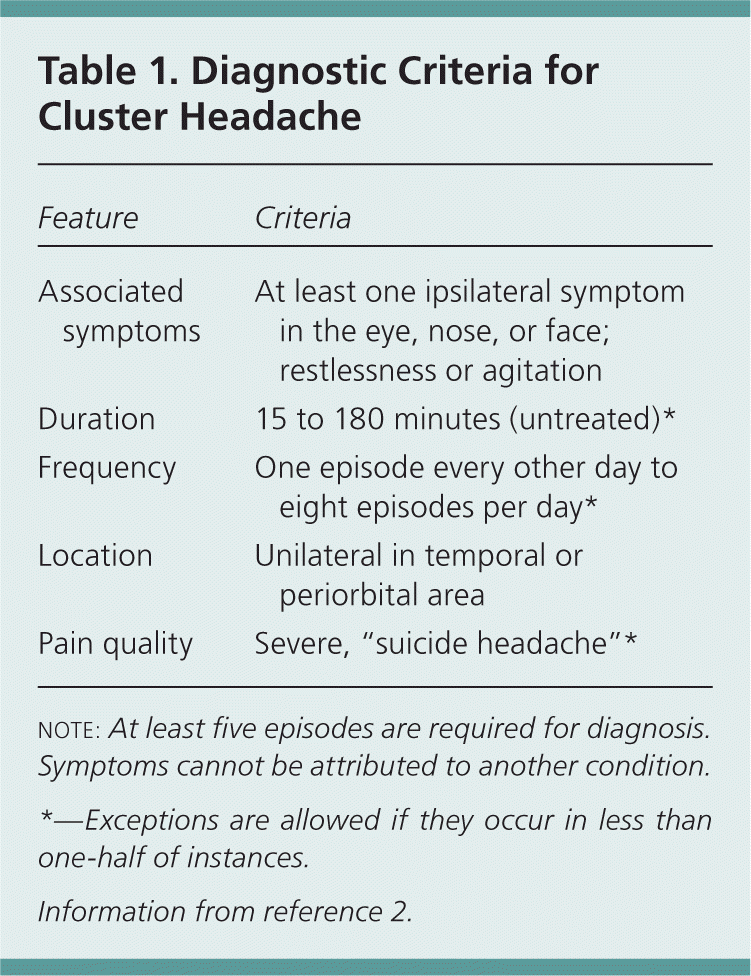
| Feature | Criteria |
|---|---|
| Associated symptoms | At least one ipsilateral symptom in the eye, nose, or face; restlessness or agitation |
| Duration | 15 to 180 minutes (untreated)* |
| Frequency | One episode every other day to eight episodes per day* |
| Location | Unilateral in temporal or periorbital area |
| Pain quality | Severe, “suicide headache”* |
Triggers for cluster headache include vasodilators (e.g., alcohol, nitroglycerin) and histamine. Tobacco exposure (i.e., history of personal use or secondhand exposure in childhood) is a risk factor for the development of cluster headache.6 The unique pattern and constellation of symptoms usually makes the diagnosis of cluster headache fairly evident, but other headache disorders may present with overlapping or similar features (Table 27 ). Neuroimaging has not proved useful in the diagnosis of cluster headache, but is indicated in patients who have red flag headache features (e.g., sudden change in the nature of the headache, symptoms that suggest a pituitary mass) or abnormal findings on neurologic examination.
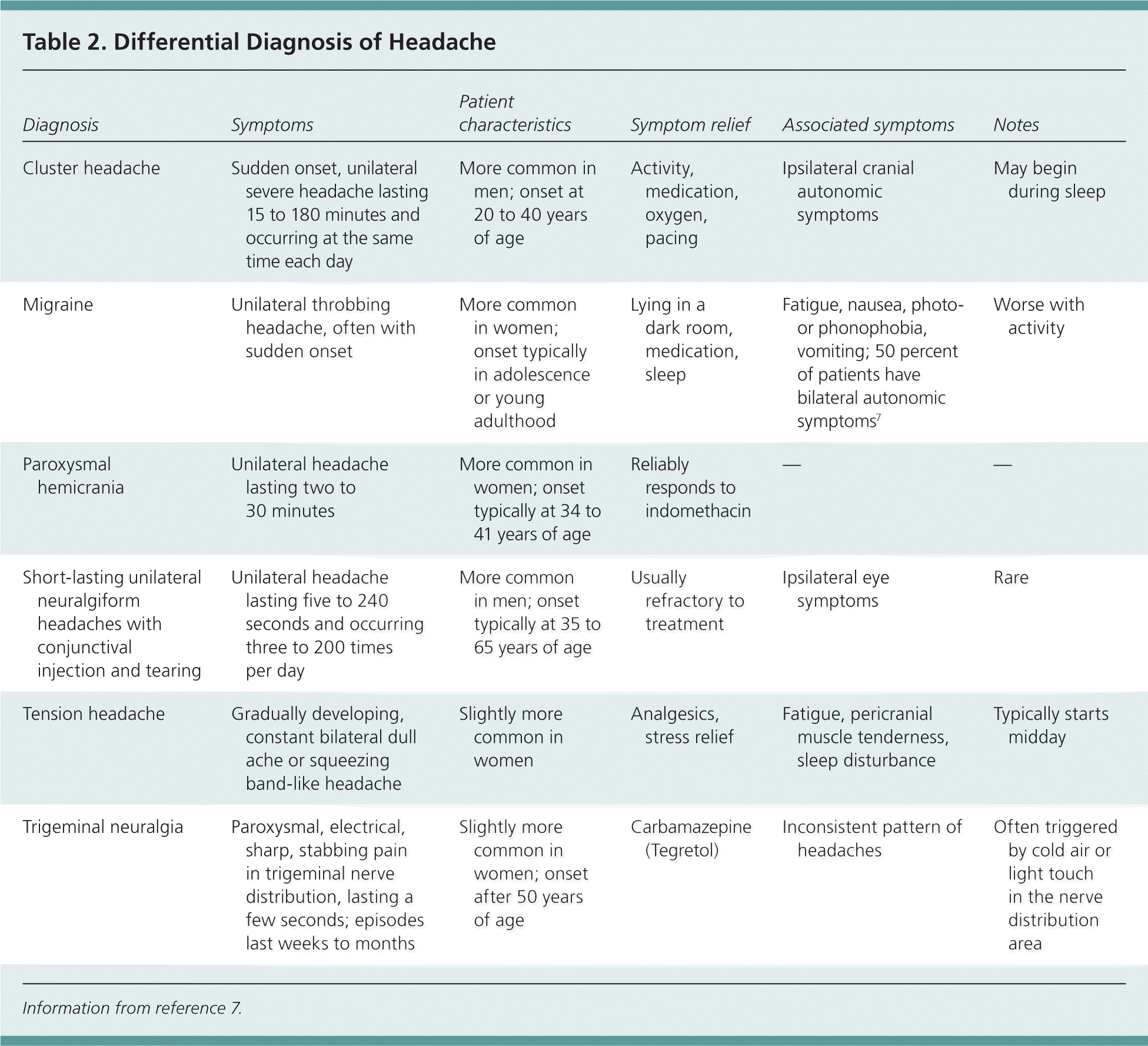
| Diagnosis | Symptoms | Patient characteristics | Symptom relief | Associated symptoms | Notes |
|---|---|---|---|---|---|
| Cluster headache | Sudden onset, unilateral severe headache lasting 15 to 180 minutes and occurring at the same time each day | More common in men; onset at 20 to 40 years of age | Activity, medication, oxygen, pacing | Ipsilateral cranial autonomic symptoms | May begin during sleep |
| Migraine | Unilateral throbbing headache, often with sudden onset | More common in women; onset typically in adolescence or young adulthood | Lying in a dark room, medication, sleep | Fatigue, nausea, photo- or phonophobia, vomiting; 50 percent of patients have bilateral autonomic symptoms7 | Worse with activity |
| Paroxysmal hemicrania | Unilateral headache lasting two to 30 minutes | More common in women; onset typically at 34 to 41 years of age | Reliably responds to indomethacin | — | — |
| Short-lasting unilateral neuralgiform headaches with conjunctival injection and tearing | Unilateral headache lasting five to 240 seconds and occurring three to 200 times per day | More common in men; onset typically at 35 to 65 years of age | Usually refractory to treatment | Ipsilateral eye symptoms | Rare |
| Tension headache | Gradually developing, constant bilateral dull ache or squeezing band-like headache | Slightly more common in women | Analgesics, stress relief | Fatigue, pericranial muscle tenderness, sleep disturbance | Typically starts midday |
| Trigeminal neuralgia | Paroxysmal, electrical, sharp, stabbing pain in trigeminal nerve distribution, lasting a few seconds; episodes last weeks to months | Slightly more common in women; onset after 50 years of age | Carbamazepine (Tegretol) | Inconsistent pattern of headaches | Often triggered by cold air or light touch in the nerve distribution area |
Etiology and Pathophysiology
The pathophysiology of cluster headache is not fully understood. Current theories implicate mechanisms such as vascular dilation, trigeminal nerve stimulation, and circadian effects. Histamine release, an increase in mast cells, genetic factors, and autonomic nervous system activation may also contribute.
Acute cluster headache has been shown to involve activation of the posterior hypothalamic gray matter, and is inherited as an autosomal dominant condition in about 5% of patients.2 Having a first-degree relative with cluster headache increases the risk 14- to 39-fold.8 One study showed an association between cluster headache and the HCRTR2 gene.8 Disturbed circadian rhythms have been suggested as a possible contributor because headaches often begin during sleep.
Management
Effective management of cluster headache requires the integration of several strategies. Patient education is important, and should focus on managing or avoiding triggers, with an emphasis on smoking cessation, alcohol counseling, and lifestyle modification. Abortive treatments should be used to alleviate acute headaches. Prophylactic therapy should be started and continued for the duration of the expected cluster period, then tapered. Patients who have chronic cluster headache should continue maintenance medications indefinitely. More invasive treatment options, including surgical interventions, are used only when other treatment modalities are ineffective. Complementary and alternative medicine approaches have provided inconclusive results.
ACUTE OR ABORTIVE TREATMENT
Triptans and supplemental oxygen are first-line abortive therapies for cluster headache9 (Table 39,10 ). A double-blind, randomized, placebo-controlled crossover trial showed that inhaled high-flow oxygen (12 L per minute) was more effective than placebo in eliminating pain at 15 minutes.11 Complete pain relief was reported in 78% of patients. One low-power study suggested better outcomes from hyperbaric vs. normobaric oxygen, but cost and limited availability inhibit its use.12 No evidence indicates that supplemental oxygen prevents future cluster episodes.
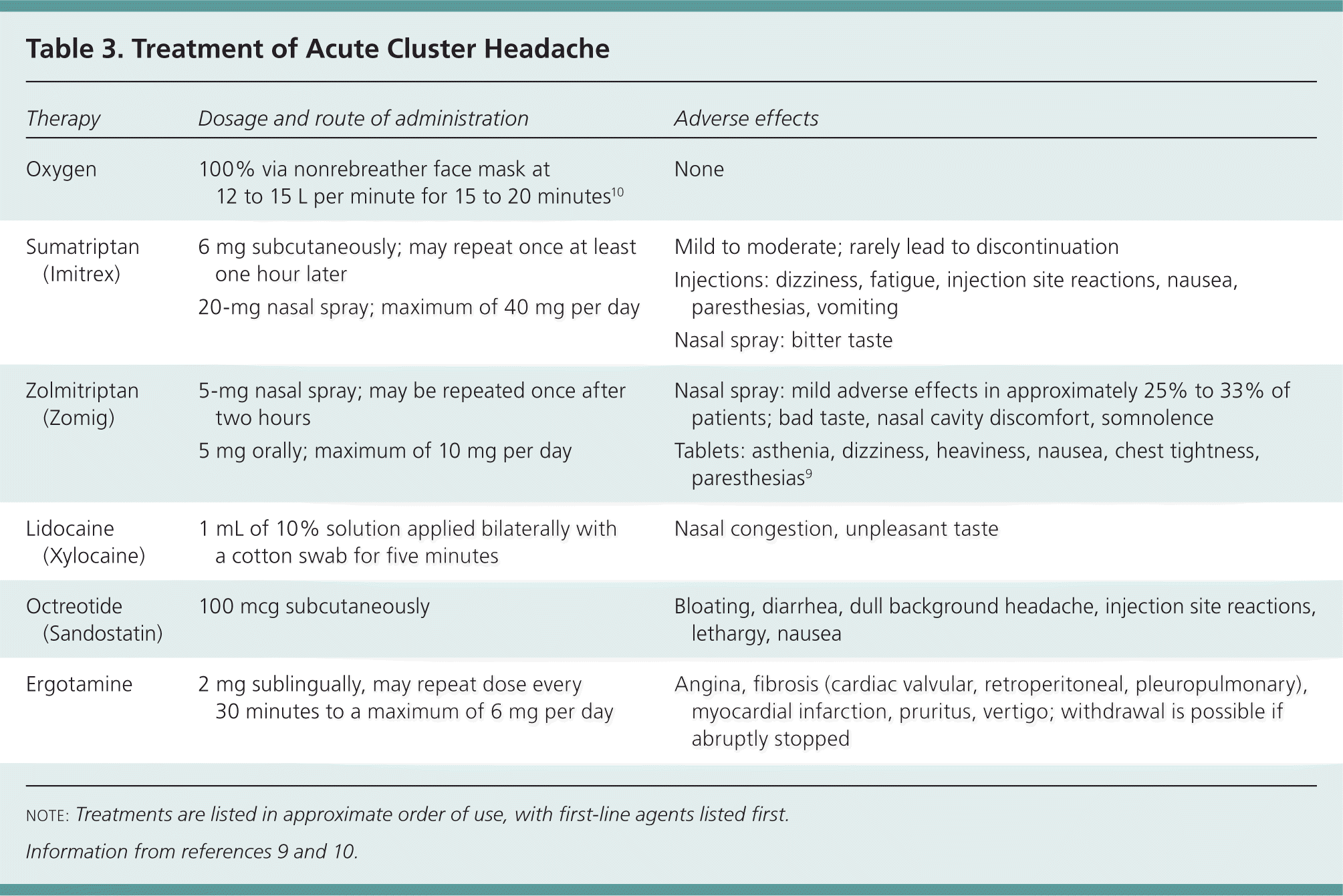
| Therapy | Dosage and route of administration | Adverse effects |
|---|---|---|
| Oxygen | 100% via nonrebreather face mask at12 to 15 L per minute for 15 to 20 minutes10 | None |
| Sumatriptan (Imitrex) | 6 mg subcutaneously; may repeat once at least one hour later | Mild to moderate; rarely lead to discontinuation |
| Injections: dizziness, fatigue, injection site reactions, nausea, paresthesias, vomiting | ||
| 20-mg nasal spray; maximum of 40 mg per day | Nasal spray: bitter taste | |
| Zolmitriptan (Zomig) | 5-mg nasal spray; may be repeated once after two hours | Nasal spray: mild adverse effects in approximately 25% to 33% of patients; bad taste, nasal cavity discomfort, somnolence |
| 5 mg orally; maximum of 10 mg per day | Tablets: asthenia, dizziness, heaviness, nausea, chest tightness, paresthesias9 | |
| Lidocaine (Xylocaine) | 1 mL of 10% solution applied bilaterally with a cotton swab for five minutes | Nasal congestion, unpleasant taste |
| Octreotide (Sandostatin) | 100 mcg subcutaneously | Bloating, diarrhea, dull background headache, injection site reactions, lethargy, nausea |
| Ergotamine | 2 mg sublingually, may repeat dose every 30 minutes to a maximum of 6 mg per day | Angina, fibrosis (cardiac valvular, retroperitoneal, pleuropulmonary), myocardial infarction, pruritus, vertigo; withdrawal is possible if abruptly stopped |
One randomized, double-blind, placebo-controlled study found that a 6-mg subcutaneous dose of sumatriptan (Imitrex) has a number needed to treat (NNT) of 2.4 for pain relief at 15 minutes, with response in 75% of patients vs. 32% in those who received placebo.13 A 12-mg dose did not provide significantly better outcomes than 6 mg, but was associated with more adverse effects.14 A multicenter, double-blind, randomized study of zolmitriptan (Zomig) showed significant pain improvement at 30 minutes in treated patients compared with those who received placebo.9 In this study, placebo was 30% effective, compared with 50% and 63.3%, respectively, for zolmitriptan nasal spray in 5-mg and 10-mg doses. A systematic review showed that a 10-mg intranasal dose of zolmitriptan has an NNT of 2.8 for pain relief at 30 minutes.13 Triptans are contraindicated in patients with vascular risks, including ischemic heart disease. Predicting response to these therapies by individual patients is difficult. Older age seems to negatively affect triptan response. Similarly, restlessness, nausea, and vomiting may be negative predictors of response to supplemental oxygen.15
Other treatment options with weaker supporting evidence include intranasal lidocaine (Xylocaine), octreotide (Sandostatin), and ergotamine. One review concluded that there is insufficient evidence to endorse the use of dihydroergotamine (Migranal), ergotamine, somatostatin, and prednisone for the acute treatment of cluster headache.9 Cluster headache is typically resistant to indomethacin. Some case reports suggest that, compared with other paroxysmal hemicranias, cluster headache may have a delayed response to indomethacin, and that patients may respond to larger doses.16
PROPHYLAXIS
Verapamil at a minimum dosage of 240 mg per day is first-line prophylaxis for cluster headache9,17 (Table 418 ). Electrocardiographic monitoring is necessary because of potential cardiac effects. One randomized controlled trial reported statistically significant decreases in the number of headaches per day after two weeks of treatment.19 Another study comparing verapamil and lithium showed a 50% reduction in the number of headaches in the verapamil group.9 Oral steroids have been used, but their effectiveness is not supported by adequate randomized controlled trials. Steroids are probably most useful as bridging therapy until another prophylactic medication is established. Transitional bridging therapy is most often needed to reduce overuse of triptans and the need for supplemental oxygen in patients who have frequent headaches. Other prophylactic treatments that have limited evidence of success include suboccipital steroid injections, valproic acid (Depakene), topiramate (Topamax), ergotamine, melatonin, and capsaicin.18
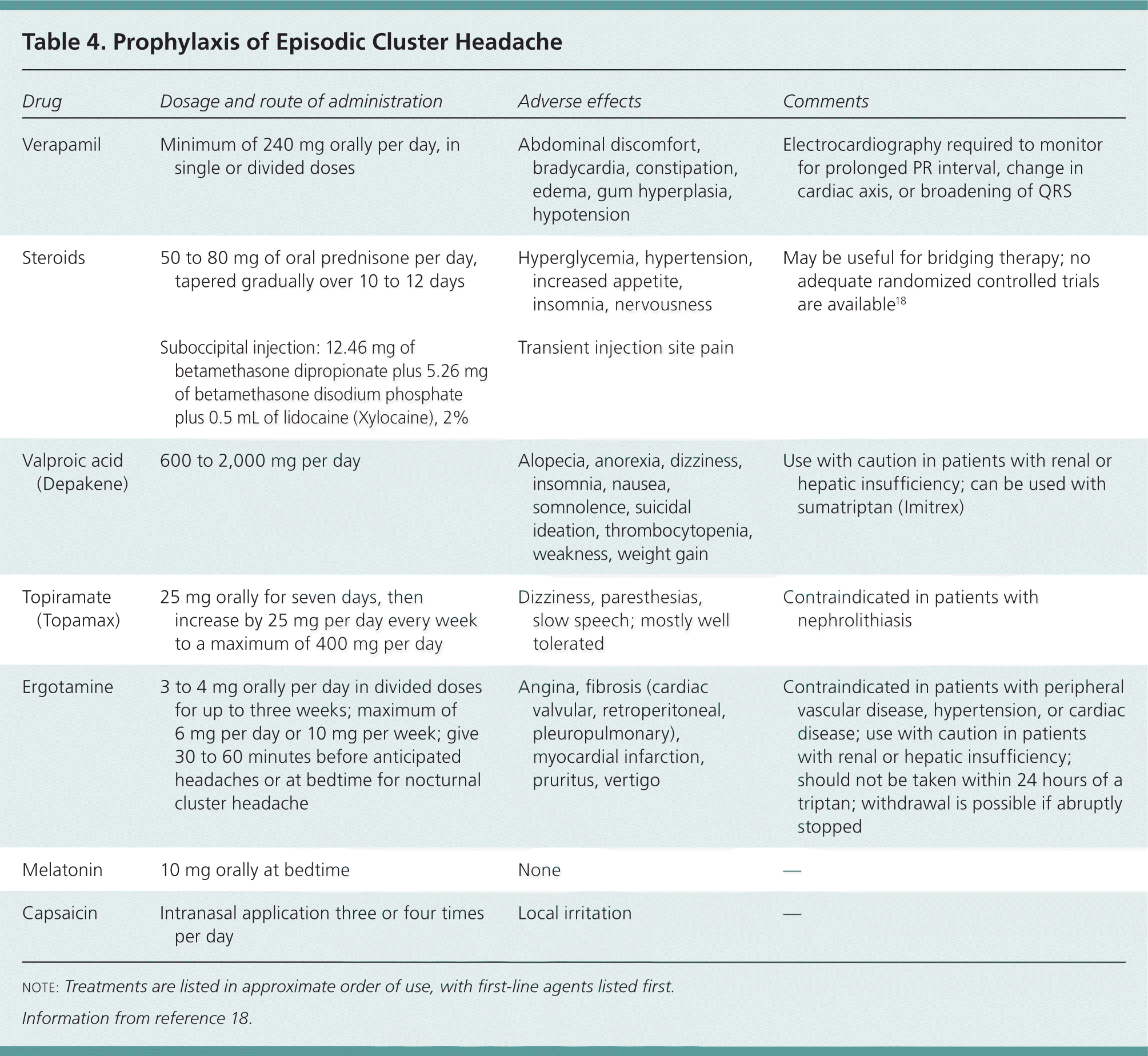
| Drug | Dosage and route of administration | Adverse effects | Comments |
|---|---|---|---|
| Verapamil | Minimum of 240 mg orally per day, insingle or divided doses | Abdominal discomfort,bradycardia, constipation,edema, gum hyperplasia,hypotension | Electrocardiography required to monitorfor prolonged PR interval, change incardiac axis, or broadening of QRS |
| Steroids | 50 to 80 mg of oral prednisone per day, tapered gradually over 10 to 12 days | Hyperglycemia, hypertension, increased appetite, insomnia, nervousness | May be useful for bridging therapy; no adequate randomized controlled trials are available18 |
| Suboccipital injection: 12.46 mg of betamethasone dipropionate plus 5.26 mg of betamethasone disodium phosphate plus 0.5 mL of lidocaine (Xylocaine), 2% | Transient injection site pain | ||
| Valproic acid (Depakene) | 600 to 2,000 mg per day | Alopecia, anorexia, dizziness, insomnia, nausea, somnolence, suicidal ideation, thrombocytopenia, weakness, weight gain | Use with caution in patients with renal or hepatic insufficiency; can be used with sumatriptan (Imitrex) |
| Topiramate (Topamax) | 25 mg orally for seven days, then increase by 25 mg per day every week to a maximum of 400 mg per day | Dizziness, paresthesias, slow speech; mostly well tolerated | Contraindicated in patients with nephrolithiasis |
| Ergotamine | 3 to 4 mg orally per day in divided doses for up to three weeks; maximum of 6 mg per day or 10 mg per week; give 30 to 60 minutes before anticipated headaches or at bedtime for nocturnal cluster headache | Angina, fibrosis (cardiac valvular, retroperitoneal, pleuropulmonary), myocardial infarction, pruritus, vertigo | Contraindicated in patients with peripheral vascular disease, hypertension, or cardiac disease; use with caution in patients with renal or hepatic insufficiency; should not be taken within 24 hours of a triptan; withdrawal is possible if abruptly stopped |
| Melatonin | 10 mg orally at bedtime | None | — |
| Capsaicin | Intranasal application three or four times per day | Local irritation | — |
A randomized, double-blind, placebo-controlled study of steroid injections showed that 85% of the 23 patients were pain-free in 72 hours, and 62% of responders remained headache-free for four to 26 months.9 Based on current evidence, one review suggested that sumatriptan, valproate (Depacon), misoprostol (Cytotec), supplemental oxygen, cimetidine (Tagamet), and chlorpheniramine should not be used for preventive treatment, and found that there is insufficient evidence to recommend the use of intranasal capsaicin and prednisone.9
TREATMENT OF CHRONIC CLUSTER HEADACHE
Verapamil and lithium are the mainstays of treatment for chronic cluster headache9,17 (Table 520 ). A double-blind crossover study comparing verapamil and lithium reported a 50% reduction in the headache index for the verapamil group and a 37% reduction for the lithium group.9 Deep brain stimulation is also an option for refractory chronic cluster headache, although it is not entirely clear how it works.20 A prospective crossover, double-blind, multicenter study comparing deep brain stimulation and sham treatment reported no effect in the first month, but suggested benefit in more than one-half of patients one year after treatment.21
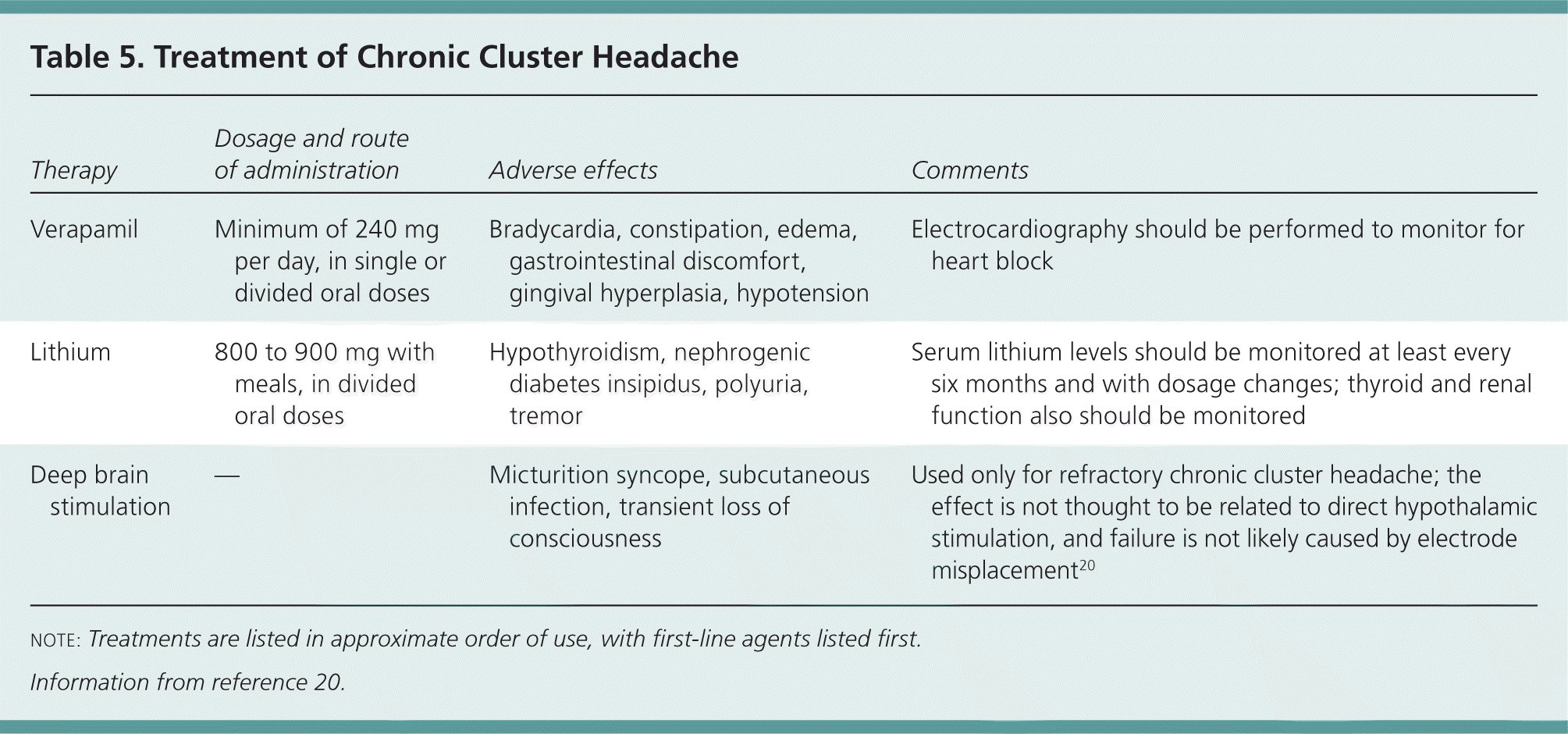
| Therapy | Dosage and route of administration | Adverse effects | Comments |
|---|---|---|---|
| Verapamil | Minimum of 240 mg per day, in single or divided oral doses | Bradycardia, constipation, edema, gastrointestinal discomfort, gingival hyperplasia, hypotension | Electrocardiography should be performed to monitor for heart block |
| Lithium | 800 to 900 mg with meals, in divided oral doses | Hypothyroidism, nephrogenic diabetes insipidus, polyuria, tremor | Serum lithium levels should be monitored at least every six months and with dosage changes; thyroid and renal function also should be monitored |
| Deep brain stimulation | — | Micturition syncope, subcutaneous infection, transient loss of consciousness | Used only for refractory chronic cluster headache; the effect is not thought to be related to direct hypothalamic stimulation, and failure is not likely caused by electrode misplacement20 |
SURGICAL AND OTHER INVASIVE OPTIONS
In a study of 14 patients, occipital nerve stimulation produced improvement in 71% of participants, and 62% of those who responded to the treatment remained headache-free for four to 26 months.17 The intensity of headaches was also decreased, although some patients had a lag of at least two months between the electrode implantation and clinical effect.3 Trigeminal nerve radiosurgical treatment is not recommended for patients with chronic cluster headache because of the lack of benefit and a high rate of new trigeminal nerve disturbances.22 Retrospective studies on radiofrequency treatment of the ganglion pterygopalatinum have shown inconsistent results and adverse effects including epistaxis, bleeding in the jaw, and loss of sensation of the palatum.3
COMPLEMENTARY AND ALTERNATIVE MEDICINE APPROACHES
A systematic review of complementary and alternative therapies for nonmigraine headaches included studies of acupuncture, spinal manipulation, electrotherapy, physiotherapy, homeopathy, herbal heat rub, and therapeutic touch, but none of these studies specifically addressed cluster headache.23 There is some supporting evidence for the use of electrotherapy to cranial muscles in patients with nonmigraine headache, but not all of the studies are of high quality.24 Spinal manipulation may be more effective than massage or placebo to alleviate cervicogenic headache.24
SPECIAL POPULATIONS
Cluster headache is rare during pregnancy, but treatment is challenging. Pregnant women should use the fewest medications possible, for the shortest amount of time, and at the lowest dosage that controls symptoms. Preferred treatments in pregnant women include supplemental oxygen and subcutaneous or intranasal sumatriptan for acute treatment, with verapamil or prednisone or prednisolone as prophylactic therapy. Gabapentin (Neurontin) may be used as an alternative. Supplemental oxygen, sumatriptan, and lidocaine are first-line therapies for acute treatment in women who are breastfeeding; verapamil, oral steroids, and lithium are recommended prophylactic medications.21
Data Sources: A PubMed search was completed in Clinical Queries using the key terms cluster and headache. The search included meta-analyses, systematic reviews, randomized controlled trials, prospective studies, case studies, and reviews. Also searched were the Database of Abstracts of Reviews of Effects, the Cochrane database, the Institute for Clinical Systems Improvement, Essential Evidence Plus, UpToDate, evidence-based guidelines from the National Guideline Clearinghouse, and clinical guidelines and evidence reports from the Agency for Healthcare Research and Quality. Search date: February 2, 2012.
